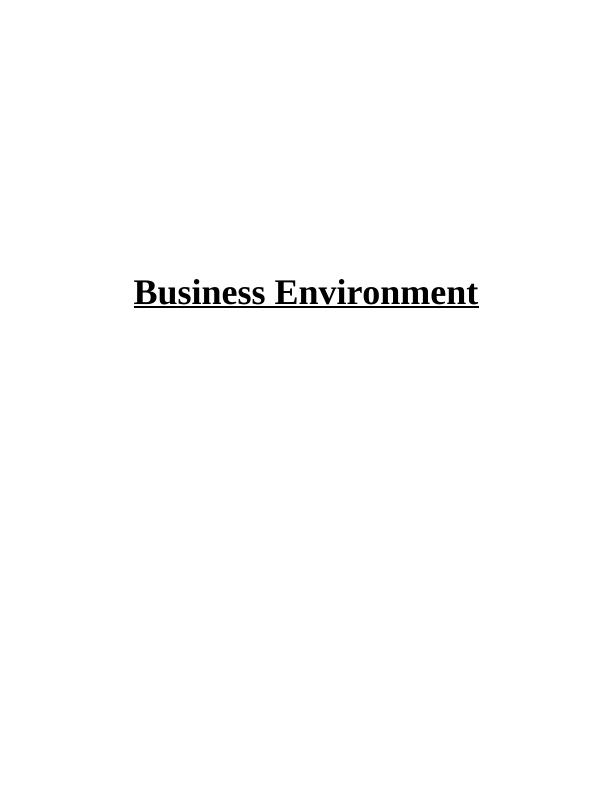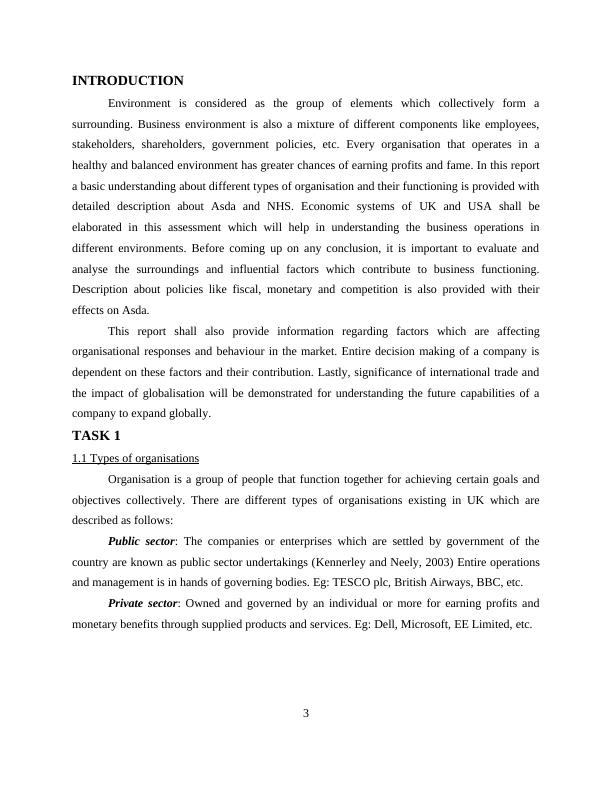Business Environment INTRODUCTION 3 TASK 13 1 Types of organisations
Added on 2020-02-17
29 Pages4883 Words379 Views
Business Environment

TABLE OF CONTENTSINTRODUCTION...........................................................................................................................3TASK 1............................................................................................................................................31.1 Types of organisations...........................................................................................................31.2 Extent to which organisation meets objectives of stakeholders............................................41.3 Responsibilities and strategies (M1, D1)...............................................................................5TASK 2............................................................................................................................................62.1 Economic systems of UK attempt to allocate resources effectively......................................62.2 Enclosed in ppt......................................................................................................................82.3 Impact of competition policy and regulatory mechanisms..................................................15TASK 3..........................................................................................................................................153.1 Market structures.................................................................................................................153.2 Market forces shaping organisational responses.................................................................163.3 Business and cultural environment shaping behaviour of Virgin Atlantic (M3, D3)..........17TASK 4..........................................................................................................................................194.1 Enclosed in ppt.....................................................................................................................194.2 Impact of global factors on UK business organisations......................................................254.3 Impact of EU policies..........................................................................................................26CONCLUSION..............................................................................................................................26REFERENCES..............................................................................................................................282

INTRODUCTIONEnvironment is considered as the group of elements which collectively form asurrounding. Business environment is also a mixture of different components like employees,stakeholders, shareholders, government policies, etc. Every organisation that operates in ahealthy and balanced environment has greater chances of earning profits and fame. In this reporta basic understanding about different types of organisation and their functioning is provided withdetailed description about Asda and NHS. Economic systems of UK and USA shall beelaborated in this assessment which will help in understanding the business operations indifferent environments. Before coming up on any conclusion, it is important to evaluate andanalyse the surroundings and influential factors which contribute to business functioning.Description about policies like fiscal, monetary and competition is also provided with theireffects on Asda. This report shall also provide information regarding factors which are affectingorganisational responses and behaviour in the market. Entire decision making of a company isdependent on these factors and their contribution. Lastly, significance of international trade andthe impact of globalisation will be demonstrated for understanding the future capabilities of acompany to expand globally. TASK 11.1 Types of organisationsOrganisation is a group of people that function together for achieving certain goals andobjectives collectively. There are different types of organisations existing in UK which aredescribed as follows:Public sector: The companies or enterprises which are settled by government of thecountry are known as public sector undertakings (Kennerley and Neely, 2003) Entire operationsand management is in hands of governing bodies. Eg: TESCO plc, British Airways, BBC, etc.Private sector: Owned and governed by an individual or more for earning profits andmonetary benefits through supplied products and services. Eg: Dell, Microsoft, EE Limited, etc. 3

Sole traders: Business ownership that is entirely a copyright of one particular individualis considered as sole trading. Individual functioning of a person for earning money is known assole trader-ship. Eg: Electricians, plumbers, etc.Non-profit or voluntary: Generally, these institutions aim to provide their services andproducts without considering profits and being owned or governed by government or singleindividual (Stalk, Evans and Shulman, 2001). These are set up with an aim of providing equalservices to everyone. Eg: Oxfam.NHSNHS is the leading public sector organisation in UK that has been providing its servicesin health and social care. The purpose of this institution is to provide unhindered services to localcitizens as well as foreign immigrants without compromising quality of care (NHS Choices,2017). This promising statement defines the purpose of giving selfless services without thinkingabout profit. Asda Stores Ltd.Asda is one of the leading supermarket retailers of the country with private ownership.The company has been listed amongst top supermarket holders recently (About Us, 2017).Purpose of functioning for Asda is to make goods and services affordable for everyone in thesociety. Despite of a profit earning approach, the company aims to provide its products with acorporate social responsibility.1.2 Extent to which organisation meets objectives of stakeholdersStakeholders are entities that hold interest in functioning of a business organisation eitherin the form of profits or in the form of products and services (Botha, Kourie and Snyman, 2014).For instance, Asda Stores Ltd. is a retail sector company. Henceforth, the stakeholders of thisorganisation shall be customers who require goods from the supermarket. Stakeholders arebasically divided into two categories:Internal: Employees, shareholders, suppliersExternal: Customers, government, partners.Stakeholders share a collective objective of achieving great quality products and serviceswith high profits and monetary benefits. Although there may be certain fluctuations when itcomes to personal targets or goals. For instance, customers will have an objective of getting best4

quality products in affordable price range. On the other hand, employees aim that respectivecompany shall achieve huge profits so that their salary and monetary benefits are increased. NHS works with different voluntary organisations as its partners and shareholders.Government takes serious measures and provides alternatives to patients and people who requirespecific attention in terms of health and social care. Moreover, increasing opportunities fordoctors and other service providers (internal stakeholders) to achieve their objectives or earningmaximum through NHS. The organisation also takes appropriate steps in safeguardingindividuals or external stakeholders from exploitation and abuse in different forms. Considering the case of Asda, external stakeholders are majorly customers andgovernment. Products or goods which are provided at the supermarkets are of great quality andcomparatively cheaper from other competitors. This has helped customers achieve theirobjective. Government is getting benefits in the form of economic growth and effectivecontributions to GDP (Reynolds and Rohlin, 2014). On the other hand, increasing number ofsupermarkets has helped in generating employment for the company. Convenience and comfortis the first and foremost important condition that a customer takes into consideration whilepurchasing products and services. Asda has given this attribute to its external stakeholders byproviding online shopping options. In this way, it is quite clear that Asda and NHS are able tomeet the objectives and expectations of their stakeholders efficiently.1.3 Responsibilities and strategies (M1, D1)Every business organisation has certain roles and responsibilities towards the country andthe stakeholders. Often private sector industries are perceived as selfish and profit oriented. ButAsda has changed this perception and developed a purpose with a humane touch. It aims toprovide purchasing opportunity to everyone by giving goods at affordable pricing (Kim, Sureshand Kocabasoglu-Hillmer, 2013). Following responsibilities are to be followed by the company:1.To function with corporate social responsibility.2.Providing equal opportunities to employees and other internal stakeholders.3.Cultural and social balance must be created when business functions are executed by thecompany. 4.Fair pricing and use of regulatory standards in the development of products and servicesis the prime responsibility of Asda.5

When company has a clear vision about the responsibilities it has to fulfil, then strategicdecision making process becomes efficient. If any of the aforementioned duties are neglected bythe organisation, then there are chances of declining customer share and as a result profit marginsare affected (Adam and Billi, 2014). Following strategies are devised by leaders of the companyfor meeting set responsibilities and fulfilling respective duties efficiently.1.Using ethical governance with corporate social responsibility: This strategy helps ingiving equal opportunities to employees as well as tackle suppliers with fair trade.Company's corporate image is enhanced when ethical practises are initiated in everyfunctional aspect.2.Communication channel: Effective communication channels help in transferringinformation from one place to another without any discrepancies. In order to protectcredentials from misuse by rivals and competitors, Asda has worked out a securecommunication channel. Access to this channel is limited to internal members of theorganisation. Moreover, employees and customers can communicate their queries andcomplaints easily to organisation chief for quick solutions (Baker, Bloom and Davis,2016).3.ISO 9000 standards are followed by Asda for creating good quality products anddelivering best in class services for the customers. These certificates are a mode ofquality assurance and standards which are not compromised by the company.The responsibilities of Asda are eventually met when aforementioned strategies areimplemented appropriately. Use of ISO standards helps in achieving sustainability only whentime to time validation of certificates is done. Asda can gain the advantage of sustainablecompetitive market when all the products and services are in accordance with these standards.Moreover, communication channels have to be maintained for controlling and guiding humanresource so that production process is not hindered (Bianchi and Ilut, 2014).TASK 22.1 Economic systems of UK attempt to allocate resources effectivelyEconomic system is basically a set up where goods are distributed and resources areallocated for production. There are three basic types of economic systems, namely (Gemma,2014):6

End of preview
Want to access all the pages? Upload your documents or become a member.
Related Documents
Business Environment Assignment Solution : Asdalg...
|11
|2882
|29
Types, Size and Scope of Organisationslg...
|10
|666
|282
Business Environment Assignment - Toyota companylg...
|12
|3549
|271
Business and the Business Environmentlg...
|23
|5196
|52
Business and Business Environmentslg...
|14
|3988
|99
Business and the Business Environmentlg...
|14
|3871
|20
